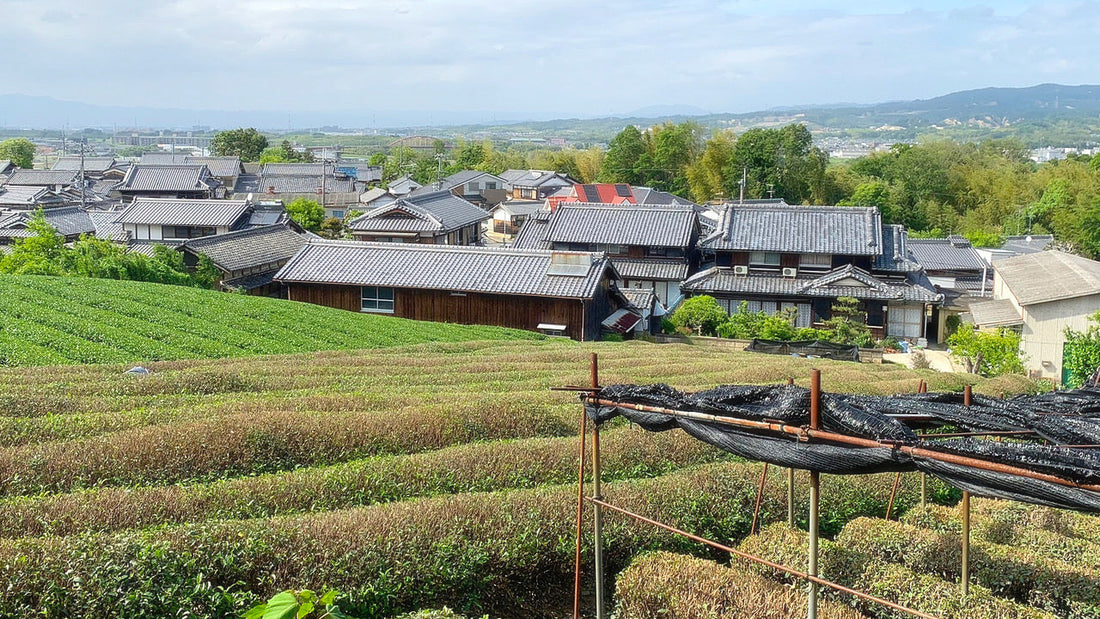
Share
How is Matcha Made?
The vibrant green powder that transforms into frothy drinks and elegant desserts follows a meticulous journey from field to cup. Understanding how matcha is made not only deepens our appreciation for this remarkable ingredient but also helps us recognize quality matcha when we see it. Let's explore the fascinating process that creates this prized green tea powder.
The Unique Climate of Uji
Situated in Kyoto Prefecture, Uji benefits from a microclimate that is ideally suited for tea production. Its fertile soil, consistent mists, and temperate weather conditions allow for the cultivation of tea plants that yield leaves of exceptional quality. This environment plays a critical role in producing the vibrant green hue and complex flavour profiles for which Uji matcha is renowned.
It Begins in the Shade
Unlike regular green tea, matcha's story starts with special cultivation techniques. About 20-30 days before harvest, tea farmers cover the plants with shade cloths, gradually reducing the amount of sunlight reaching the leaves. This shade-growing process triggers fascinating changes in the tea plants:
- Increased chlorophyll production, creating the signature vibrant green colour
- Enhanced L-theanine content, responsible for matcha's umami flavor and calming effects
- Reduced tannin development, resulting in less bitterness
- Softer, thinner leaves ideal for grinding into fine powder
This careful balance of shade and sunlight is crucial for developing the complex flavor profile and nutritional benefits that matcha is known for.

Harvesting and Processing
Timing is everything in matcha production. The finest matcha comes from the first harvest of the year, known as the first flush or 'ichibancha.' These young leaves are the most tender and nutrient-rich, offering the best flavour profile and brightest colour.
Harvesting is a precise process. Only the youngest, brightest leaves are selected, as these will produce the highest quality matcha. Traditional hand-picking ensures only the best leaves make it to processing, though some modern farms use specialized machines that can match this level of selectivity.
From Leaf to Tencha
After harvesting, the leaves undergo several critical processing steps:
Steaming: The fresh leaves are quickly steamed to prevent oxidation and preserve their vibrant green coloir. This brief steaming, typically lasting 15-20 seconds, also helps maintain the leaves' nutritional content and develops their characteristic sweet, vegetal aroma.
Drying and Cooling: The steamed leaves are rapidly cooled and then dried. This process helps maintain the leaves' color and prevents any degradation of quality.
Sorting and Cleaning: Workers meticulously remove any stems, veins, and lower-quality leaves. This step is crucial for producing smooth, high-grade matcha.
Cutting: The leaves are cut into smaller pieces to prepare for grinding. At this stage, the processed leaves are called "tencha."
 Tencha
Tencha
Stone Grinding
Perhaps the most crucial step in matcha production is the grinding process. Traditional stone mills, called "ishiusu," slowly grind tencha leaves into the superfine powder we know as matcha. This process is remarkably time-consuming – it can take up to an hour to grind just 30-40 grams of matcha.
The stone-grinding process must be done with extreme care:
- The mills must turn slowly to prevent heat from friction
- Too much heat can degrade the colour and create off-flavors
- The resulting powder must be fine enough to remain suspended in water
- Each particle should be around 5-10 microns in size
While traditional stone-grinding methods are still used for premium matcha, some producers use modern manufacturing techniques for larger-scale production. The key differences often lie in: the speed of processing, the fineness of the powder, temperature control during grinding, and overall product consistency. These factors can significantly impact the final product's quality, taste, and price point.

Storage and Packaging
Once ground, matcha begins a slow quality decline. Exposure to oxygen, light, heat, and moisture can accelerate this process. Quality matcha packaging has evolved to address these challenges - from traditional metal tins that offer light and air protection, to modern resealable pouches with UV-protective properties. Regardless of packaging type, proper storage is crucial: keep your matcha in its original sealed container in a cool, dry place, and aim to enjoy it within three months of opening.

The traditional production of matcha is a true art form, reflecting the dedication and expertise of its producers. Each step, from shading the tea bushes to the slow stone grinding, is carried out with precision and care, ensuring that every scoop of matcha powder offers maximum flavour and health benefits. As you savour your next cup of matcha, take a moment to appreciate the centuries-old practices and the meticulous craftsmanship that make this extraordinary tea a cherished ritual in homes and tea ceremonies around the world.